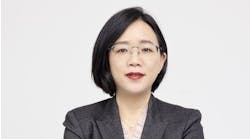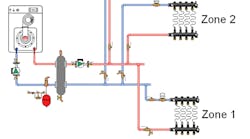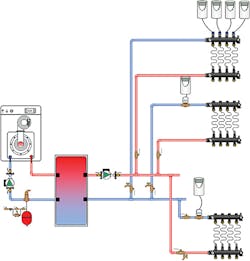Several years ago, I was on vacation in the Black Hills of South Dakota with my wife Kathy and two of our grandchildren. We had just passed the heads of the presidents on Mount Rushmore when a small herd of mountain goats crossed the road in front of us.
These animals are very reclusive and rare to see, especially this close up, so this was a real photo opportunity. I quickly parked the car along the side of the road and was busy snapping photos when I felt a tap on the shoulder and a stern voice saying, “Excuse me.”
I turned and found myself nose to nose with a forest ranger. Behind him, his Jeep had the flashing red lights going. I asked him, “Is there a problem?” He replied, “Which one of the seven No Parking signs did you not see?”
A quick look over my shoulder showed that I had expertly maneuvered my car directly between two No Parking signs. He was kind enough to let me off without a ticket, but it showed how easily we can be surrounded by signs and still not see them; or, more importantly, do anything about them.
We are constantly surrounded by signs. For the most part, we understand they are useful and helpful. But let me show you one sign that’s especially important to heed.
Problems With Short Cycling
Imagine this scenario: It’s -20°F outside. You walk into your mechanical room and listen to the boiler firing. Your boiler fires for three minutes and shuts off. Three minutes later, it fires again for three minutes and shuts off. This is a sign of a serious problem, called “short cycling.”
There are multiple reasons for short cycling, but one of the most common occurs when an oversized boiler quickly satisfies heating demands and then shuts down until heat is needed again. This short cycling results in premature boiler failure, increased heating costs and poor heating system performance.
Often, when I encounter someone who says, “I had radiant floor heating once, but it didn’t keep the house warm, and it cost a fortune to run,” I can say with almost 100% certainty they had a short-cycling system (and probably other issues, too). If the boiler size is wrong to begin with, almost everything else is sized wrong as well.
Fortunately for us, the newer modulating condensing boilers can often eliminate this problem, since their flame is able to modulate down to the desired BTU output, thus eliminating short cycling. This is true most of the time — but not always.
So, let’s see if we can spot the signs of a problem in the two scenarios below.
Scenario #1: a 90,000-BTU, non-condensing boiler with baseboard radiators that require 45,000 BTUs of output. This is a classic scenario for short cycling. To prevent short cycling, the boiler’s output should be just slightly higher than the heat requirements of the load. As you can see from this, unless the heat loss analysis is done right, you’re just guessing at what size boiler you would need.
Scenario #2: A 65,000 BTU, modulating condensing boiler with a 5-to-1 turndown ratio (refer to the system layout drawing below). With this turndown ratio, the smallest flame that the boiler can produce is 13,000 BTU (65,000 ÷ 5). The load side of the system has six separate zones. Zones 1 and 2 require 20,000 BTUs each for a total of 40,000 BTUs. Zones 3 through 6 are four, 5,000-BTU loads for a total of 20,000 BTUs.
In this system, everything will run fine when all the zones are calling. The boiler matches the system very well.
Now, suppose we have a situation where only Zone 5 is calling. Zone 5 only needs 5,000 BTUs, but the smallest flame that the boiler can produce is 13,000 BTUs. Short cycling will now occur.
This is not a particularly bad case of short cycling. But I have seen these types of systems drive up heating bills to double what they should be and still not be able to heat the zone.
To address the problem, here is what should have happened during the design phase: The boiler should’ve been designed so the smallest flame it is capable of producing is just a little higher than the smallest heating load (sometimes called a “microload”).
WARNING: Oversizing a modulating condensing boiler, causing it to fire for long periods of time on low fire, may destroy the burner head.
So how do we fix this scenario? There are two options: First, change out the boiler to match the microload. (This is very expensive, and now you’re stuck with a used boiler.) The second is to install a buffer tank.
How buffer tanks improve performance
A buffer tank is a storage tank that allows the boiler to produce heat and store it in an insulated tank to be used by the microload whenever needed, thus eliminating short cycling. This is similar to the flywheel effect of oversized motors.
What size buffer tank is needed? Let’s assume a few key points:
· We want the boiler to fire for a minimum of 15 minutes.
· The microload needs a minimum of 90°F supply water temperature when the outside temperature is at its coldest.
· Typically you’d like to raise the temperature of the buffer tank approximately 30 degrees to provide plenty of heat on those cold days, so it would raise the temperature of the buffer tank to 120°F.
Below is the formula for sizing the buffer tank.
Where:
• V = required volume of the buffer tank (gallons).
• t = desired duration of the heat source’s “on” cycle (typically 15 minutes).
• qheatsource = heat output rate of the heat source, expressed in Btu/hour (in this case, 65,000 BTUs).
• qload = rate of heat extraction from the tank, expressed again in Btu/h (in this case, 5,000 BTUs).
• rT = Temperature rise of the tank from when the heat source is turned on to when it is turned off (typically 300F).
This is what the formula would look like when it’s all filled in.
That is, the design would need a 60-gallon buffer tank.
There are different ways to design buffer tanks to handle microloads; this is just one of them. The diagram below shows how the design might look for this particular installation. We have replaced the hydraulic separator with the 60-gallon buffer tank. The buffer tank will also do the job of the hydraulic separator.
In this example, the only job of the boiler is to reheat the buffer tank. The buffer tank now becomes the heat source for the six zones. If any of them call for heat, the secondary pump comes on and draws heat from the buffer tank. When the temperature of the water inside the buffer tank drops to 90°F, the boiler activates and recharges the buffer tank. No more microload. Isn’t that clever?
So we started with a short-cycling scenario that reduced boiler life and limited system performance. But because we listened to the signs, we were able to fix the situation.
It’s all about the signs.
I would be grateful to hear your thoughts, ideas and stories. Until then, best regards and happy heating.
Steve Swanson is the national trainer at Uponor Academy. He actively welcomes reader comments and can be reached at [email protected].






